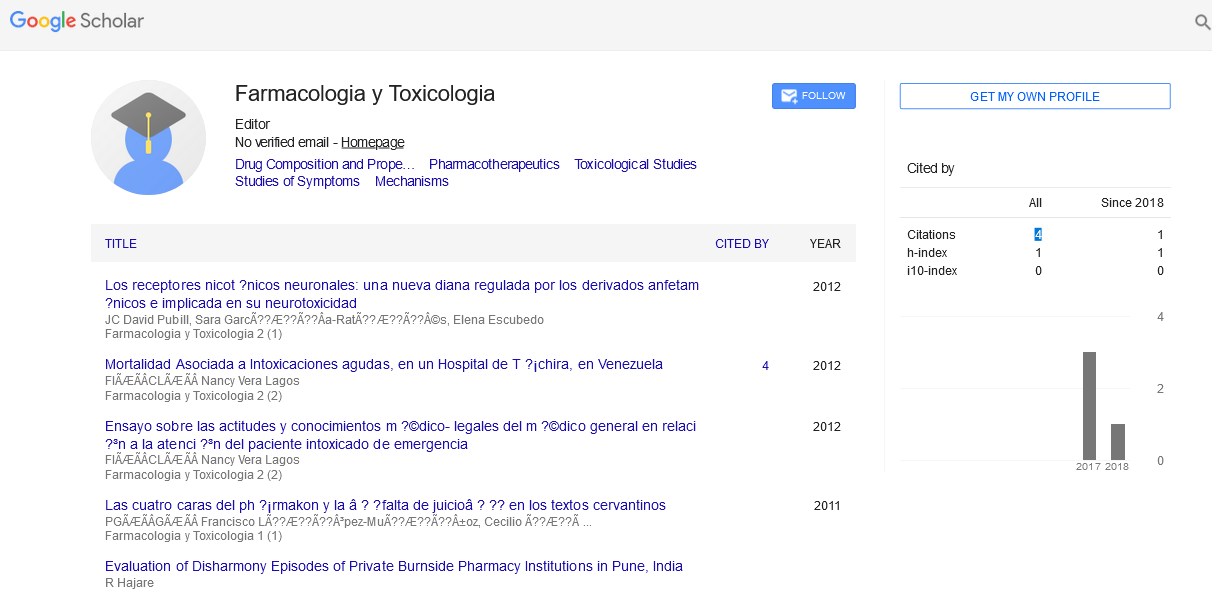Perspective - (2024) Volume 14, Issue 6
Toxins: A Deep Dive into Poisonous Substances Produced by Living Organisms
Villem Aruoja*
Department of Toxicology, University of Corneial, New York, USA
*Correspondence:
Villem Aruoja, Department of Toxicology, University of Corneial, New York,
USA,
Email:
Received: 07-Aug-2024, Manuscript No. IPFT-24-15145 ;
Editor assigned: 12-Aug-2024, Pre QC No. IPFT-24-15145 (PQ) ;
Reviewed: 26-Aug-2024, QC No. IPFT-24-15145 ;
Revised: 02-Dec-2024, Manuscript No. IPFT-24-15145 (R) ;
Published:
30-Dec-2024
Introduction
Toxins are naturally occurring poisonous substances produced
by living organisms. These substances can have profound effects
on both the organism that produces them and other life forms
that come into contact with them. Understanding toxins, their
origins and their effects is crucial in fields ranging from medicine
and environmental science to agriculture and biotechnology.
This article delves into the nature of toxins, their mechanisms
and their impact on health and the environment.
Description
Toxins
Toxins are chemical compounds that can cause harm to living
organisms. They are produced by a wide variety of organisms,
including bacteria, plants, fungi and animals. Toxins can be
classified into several categories based on their origin and the
effects they produce. For instance, bacterial toxins are produced
by microorganisms, while plant toxins are synthesized by plants
as a defense mechanism against herbivores.
Types of toxins
Bacterial toxins: These are produced by bacteria and can lead
to various diseases in humans and animals. Examples include
botulinum toxin from Clostridium botulinum, which causes
botulism and diphtheria toxin from Corynebacterium
diphtheriae, responsible for diphtheria. Bacterial toxins often
interfere with cellular processes, leading to symptoms ranging
from paralysis to severe infections.
Plant toxins: Plants produce toxins as a defense mechanism
against herbivores and pathogens. For instance, ricin from the
castor bean plant and solanine from potatoes can be highly toxic
if ingested. Plant toxins can affect various physiological systems,
including the nervous and digestive systems.
Fungal toxins: Fungi produce a range of toxins known as
mycotoxins. Aflatoxins, produced by Aspergillus species, are
carcinogenic and can contaminate crops, posing significant
health risks to humans and animals. Mycotoxins can also impact
agricultural productivity by damaging crops.
Mechanisms of toxicity
Toxins exert their effects through various mechanisms,
depending on their chemical nature and target organisms. Some
common mechanisms include:
Enzyme inhibition: Many toxins work by inhibiting specific
enzymes critical for cellular function. For example, cyanide
inhibits cytochrome c oxidase, an enzyme involved in cellular
respiration, leading to cellular hypoxia and potentially fatal
outcomes.
Cell membrane disruption: Certain toxins can disrupt cell
membranes, leading to cell death. For instance, some bacterial
toxins form pores in the cell membrane, causing leakage of
essential cellular components.
Receptor binding: Toxins can bind to specific receptors on cell
surfaces, interfering with normal cellular signaling. For example,
ricin binds to ribosomes, inhibiting protein synthesis and leading
to cell death.
Impact on health
The impact of toxins on health can range from mild symptoms
to severe, life-threatening conditions. Symptoms often depend
on the type of toxin, the dose and the route of exposure. Acute
exposure to high levels of toxins can lead to immediate health
effects, while chronic exposure to lower levels may result in
long-term health issues.
Acute toxicity: Acute toxicity occurs when an organism is
exposed to a high dose of a toxin over a short period. Symptoms
can include nausea, vomiting, diarrhea and in severe cases,
organ failure or death. For example, botulinum toxin can cause
paralysis and respiratory failure within a few days of exposure.
Chronic toxicity: Chronic toxicity results from prolonged
exposure to lower doses of a toxin. Over time, this can lead to
cumulative damage and chronic health issues. For example,
long-term exposure to aflatoxins can increase the risk of liver
cancer.
Environmental and occupational exposure: Environmental
toxins, such as pollutants and pesticides, can affect large
populations. Occupational exposure to toxins, such as asbestos
or heavy metals, poses risks to workers in certain industries.
Both environmental and occupational exposures can lead to
chronic health conditions and require stringent regulatory
measures to protect public health.
Toxin management and mitigation
Managing and mitigating the effects of toxins involves several
strategies, including:
Prevention: Preventing exposure to toxins is the most
effective way to avoid health issues. This includes implementing
safety measures in industrial settings, using protective
equipment and following guidelines for handling hazardous
substances.
Detection and monitoring: Regular monitoring and detection
of toxins in the environment, food and water are crucial for early
identification and response. Techniques such as chromatography
and spectrometry are used to detect and quantify toxins.
Treatment: In cases of poisoning, timely medical treatment is
essential. Antidotes, supportive care and decontamination procedures can help mitigate the effects of toxins. For example,
administering activated charcoal can help absorb toxins in the
gastrointestinal tract.
Conclusion
Toxins are a diverse group of poisonous substances produced
by various living organisms. Their impact on health and the
environment underscores the importance of understanding their
mechanisms and effects. Through prevention, detection and
research, we can better manage the risks associated with toxins
and protect both human and environmental health. As our
knowledge of toxins continues to grow, so too will our ability to
address the challenges they pose and ensure a safer, healthier
world.
Citation: Aruoja V (2024) Toxins: A Deep Dive into Poisonous Substances Produced by Living Organisms. Farmacologia Toxicologia, Vol.14 No.6: 060





